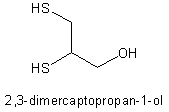METHOD OF PREPARATION
Note: This preparation should be prepared in a laminar flow hood in a cleanroom (or via isolation barrier technology) by a validated aseptic compounding pharmacist using strict aseptic technique.
1.Calculate the required quantity of each ingredient for the total amount to be prepared.
2. Accurately weigh and/or measure each ingredient.
3. Dissolve the dimercaptopropanesulfonate sodium in approximately 90 mL of sterile water for injection.
4. Add additional sterile water for injection to volume and mix well.
5. Filter through an appropriate sterile 0.2-(mu)m filter into sterile vials.
6. Package and label.
PACKAGING
Package in sterile, single-use vials.
LABELING
For professional use.
STABILITY
This preparation should be prepared just prior to administration.1
USE
Dimercaptopropanesulfonate sodium is used as an antidote in the treatment of heavy metal poisoning.2
QUALITY CONTROL
Quality-control assessment can include weight and/or volume, physical observation, pH, specific gravity, osmolality, assay, color, clarity, particulate matter, sterility, and pyrogenicity testing.3,4
DISCUSSION
Dimercaptopropanesulfonate sodium is a water-soluble analog of dimercaprol that is used in the treatment of heavy metal poisoning. It is effective in acute and chronic poisoning with arsenic, lead, inorganic and organic mercury compounds, and chromium, but is not as effective in cadmium poisoning. Generally, it is given orally in doses of 100 mg 3 to 4 times daily in chronic poisoning. However, this medication has also been administered subcutaneously or intramuscularly, as in this formulation.2
Dimercaptopropanesulfonate sodium (C^sub 3^H^sub 7^NaO^sub 3^S^sub 3^, MW 210.3, DMPS, unitiol) is water soluble and has a melting point of 235 deg C.2,5
Dimercaptopropanesulfonate sodium injection should be prepared as needed, just prior to use, and any solution remaining in the single-dose vial should be discarded, as this is a nonpreserved product.
Sterile water for injection is water for injection that has been sterilized and suitably packaged; it contains no added substances. Water for injection is water purified by distillation or by reverse osmosis and contains no added substances. Note that water for injection is not prepared by an ion-exchange process. Water is used to describe potable water from a public water supply that is suitable for drinking and is the beginning point of the official waters. It is a clear, colorless, odorless, and tasteless liquid. Purified water is water that is obtained by distillation, ion exchange, reverse osmosis, or some other suitable process. Water has a specific gravity of 0.9971 at room temperature, a melting point at 0 deg C, and a boiling point at 100 deg C. It is miscible with most polar solvents and is chemically stable in all physical states (ice, liquid, and steam).6
References
1. US Pharmacopeial Convention, Inc. United States Pharmacopeia 25/National Formulary 20. Rockville, MD:US Pharmacopeial Convention, Inc; 2001:2053-2057.
2. Reynolds JEF, ed. MARTINDALE: The Extra Pharmacopeia. 30th ed. London:The Pharmaceutical Press; 1993:697.
3. Allen LV Jr. Standard operating procedure for particulate testing for sterile products. IJPC 1998;2:78.
4. Allen LV Jr. Standard operating procedure: Quality assessment for injectable solutions. IJPC 1999;3:406-407.
5. O'Neil MJ. The Merck Index. 13th ed. Whitehouse Station, NJ:Merck & Co, Inc, 2001:3237.
6. Horry JM, Nash RA. Water. In: Kibbe AH, ed. Handbook of Pharmaceutical Excipients. 3rd ad. Washington, DC:American Pharmaceutical Association; 2000:546-549.
Copyright International Journal of Pharmaceutical Compounding Mar/Apr 2003
Provided by ProQuest Information and Learning Company. All rights Reserved



